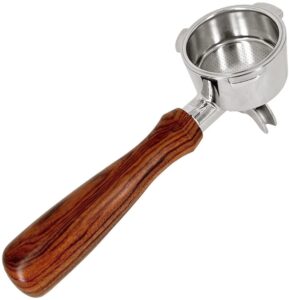“What exactly is the difference between: latte and cappuccino?” Both drinks are espresso-based, both involve milk, and both offer that warm, comforting feeling we all seek from our favorite café. Yet, the difference between lattes and cappuccinos are some distinct characteristics that set them apart.
In this blog post, we’ll explore the difference between latte and cappuccino, break down their unique characteristics, and even give you a full recipe for each drink. I’ll also share the exact machine I’ve been using that is under $200, and an even more affordable option from the same brand, that runs around $139.00. I’ve seen it on sale even lower than that many times.
What is a Cappuccino?
A cappuccino is a classic Italian coffee drink that dates back to the early 20th century. In its simplest form, it consists of equal parts espresso, steamed milk, and milk foam. This 1:1:1 ratio gives cappuccinos their signature taste and texture. The foam on top of the cappuccino adds a light, airy feel, while the espresso delivers a bold flavor.
The Key Ingredients in a Cappuccino:
- Espresso: This is the foundation of any cappuccino. It offers that deep, rich coffee flavor that shines through the milk.
- Steamed Milk: Steamed milk is added to balance out the intensity of the espresso.
- Milk Foam: Finally, a thick layer of milk foam sits on top, creating that characteristic texture and creaminess. The foam provides both an aesthetic appeal and a slight sweetness.
Cappuccino Recipe:
To make a cappuccino, you will need:
– 1 oz espresso
– 1 oz of steamed milk
– 1 oz of milk foam
Instructions:
- Start by brewing one shot of espresso using your espresso machine.
- Steam your milk using the steam wand until it reaches a creamy, frothy consistency. Be careful not to overheat the milk, as this can impact the flavor.
- Pour the steamed milk over the espresso, then add a thick layer of milk foam on top.
- For an extra touch, sprinkle cocoa powder or cinnamon on top of the foam.
What is a Latte?
A latte, short for “caffè latte,” translates to “milk coffee” in Italian. The difference between latte and cappuccino primarily lies in the milk-to-espresso ratio. Unlike a cappuccino, a latte is mostly milk, which gives it a creamier, smoother texture. A typical latte contains much more steamed milk and less foam than a cappuccino.
The Key Ingredients in a Latte:
- Espresso: Like the cappuccino, the base of a latte is a shot of espresso.
- Steamed Milk: A latte contains a larger volume of steamed milk, typically around 6-8 ounces, which creates a velvety texture.
- Milk Foam: Lattes do include a small amount of milk foam, but it’s much less than in a cappuccino, generally about a thin layer.
Latte Recipe:
To make a latte, you will need:
– 1 shot of espresso (about 1 ounce)
– 6-8 ounces of steamed milk
– A thin layer of milk foam (optional)
Instructions:
- Brew a shot of espresso using your espresso machine.
- Steam 6-8 ounces of milk until it reaches a silky, smooth texture. The goal is to heat the milk without creating too much foam.
- Pour the steamed milk over the espresso, leaving a small amount of space at the top for a thin layer of milk foam.
- If you like, add a flavoring syrup or sprinkle of nutmeg for an extra kick.
The Main Difference Between Latte and Cappuccino
Now that we’ve gone through the recipes, let’s highlight the main differences between a latte and a cappuccino. The key distinction lies in the proportions of milk and foam. A cappuccino is a stronger coffee drink with a more balanced ratio of espresso, steamed milk, and foam. On the other hand, a latte is creamier and milkier, with only a small amount of foam.
Another difference between latte and cappuccino is the texture. Cappuccinos have a thick layer of foam that creates a velvety mouthfeel, while lattes are smoother and silkier. Furthermore, the milk in a cappuccino is steamed less than in a latte, which enhances the coffee flavor in cappuccinos.
Milk Texture: The Defining Element
The milk texture is another significant difference between latte and cappuccino. In a cappuccino, the milk is foamed more aggressively, resulting in a thicker, drier foam that sits atop the espresso. This foam adds an airy element to each sip, offering a contrast between the bold espresso and the light, frothy milk.
In a latte, the milk is steamed to create a smoother, creamier texture. Since there’s less foam, the latte has a more unified consistency throughout. The milk in a latte blends seamlessly with the espresso, creating a beverage that’s ideal for those who prefer a milder coffee flavor.
How to Choose Between a Cappuccino and a Latte
When deciding between a cappuccino and a latte, it often comes down to personal preference and how much you enjoy milk with your coffee. If you like a stronger coffee taste with a more textured foam, a cappuccino might be your go-to. But, if you prefer a smoother, more velvety drink with a creamy consistency, a latte is the ideal choice.
Additionally, cappuccinos are usually smaller in size compared to lattes. A traditional cappuccino is about 6 ounces, while lattes are typically served in 8-ounce or 12-ounce cups. This size difference can also impact your choice depending on how much milk you want in your coffee.
Variations of the Latte and Cappuccino
Both cappuccinos and lattes have evolved over time, and there are now numerous variations you can try. These variations offer a fun way to customize your drink and experiment with different flavors.
Variations of the Latte:
- Flavored Latte: Popular options include vanilla, caramel, and hazelnut lattes.
- Iced Latte: Perfect for hot summer days, an iced latte is simply a chilled version of the traditional drink, served over ice.
Iced Matcha Latte
– Matcha Latte: Made with matcha powder instead of espresso, this green tea latte offers a vibrant color and earthy flavor. I have an easy recipe here for you to use that is so delicious! https://lifewithdenise.com/2024/06/matcha-latte-recipe/. Just add ice to make it an Iced Matcha Latte!
Variations of the Cappuccino:
- Dry Cappuccino: This version contains less steamed milk and more foam, offering a lighter texture.
- Wet Cappuccino: A wet cappuccino has more steamed milk and less foam, making it closer to a latte in texture.
- Flavored Cappuccinos: Just like lattes, you can add syrups to your cappuccino for extra flavor.
Which One is Healthier?
If you’re wondering about the health implications, the difference between latte and cappuccino plays a role. Cappuccinos generally contain fewer calories due to the smaller amount of milk. Lattes, with their higher milk content, will naturally have more calories, especially if you opt for whole milk.
If you’re watching your calorie intake but still want a creamy coffee, a cappuccino is likely the better option. However, both drinks can be customized with milk alternatives such as almond milk or oat milk to reduce the calorie count and cater to dietary preferences.
The Perfect Coffee Machine for Making Cappuccinos and Lattes at Home
To recreate your favorite coffee drinks at home, having the right equipment is essential. I use this machine from Amazon, which makes crafting cappuccinos and lattes a breeze. You can find it here: https://amzn.to/3ZfLrhe. This machine is perfect for beginners and seasoned coffee aficionados alike. It’s easy to use, and most of its parts are dishwasher-safe, making cleanup hassle-free. The part that is not dishwasher safe, the portafilter, can be replaced for a higher quality one that is dishwasher safe.

Pic of exact, dishwasher safe portafilter that I use for my machine. Not all portafilters fit the same machine, so if you purchase a different machine and want to upgrade your portafilter, make sure you get the right size replacement. A good quality portafilter makes all the difference when it comes to your coffee tasting of higher quality.
Here is the link to the exact portafilter that is dishwasher safe and fits this exact machine that I use. https://amzn.to/3zaUo0t
If you’re looking for a more affordable option without sacrificing quality, I highly recommend this other model from the same brand: https://amzn.to/3Xwuw8x. It’s a fantastic choice if you’re just starting out or are on a budget.
Conclusion
In summary, the difference between a latte and a cappuccino boils down to the amount of milk and foam. Cappuccinos offer a stronger coffee flavor with a textured foam, while lattes are creamier and smoother. Whether you prefer the boldness of a cappuccino or the velvety texture of a latte, both drinks can be customized to fit your taste preferences.
Now that you know the difference between latte and cappuccino, why not try making them at home? With the right tools, you can enjoy your favorite coffee drinks without leaving your kitchen. And don’t forget to check out the espresso machines I mentioned above—they make all the difference when it comes to crafting the perfect cup of coffee.
If you all have any questions, or just want to show me the delicious lattes and cappuccinos you make at home, feel free to tag me on Instagram, @realdenisewilliams. Can’t wait to see all your delicious coffees! If you want to learn how to make a delicious and healthy matcha latte without any special equipment, follow this link: https://lifewithdenise.com/2024/06/matcha-latte-recipe/



